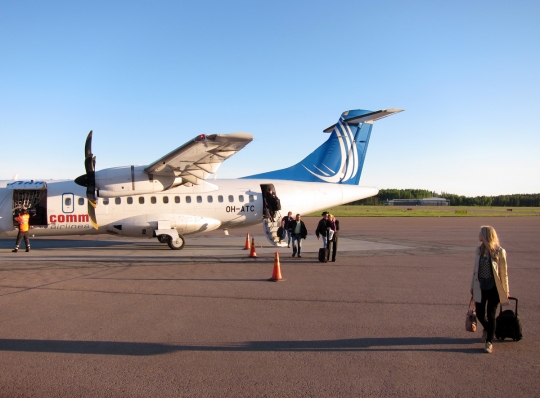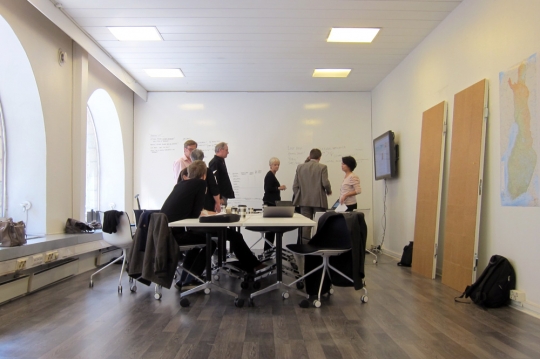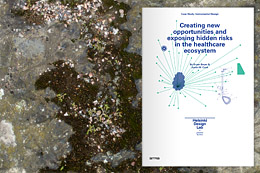HDL Studios
Posts tagged with "How-To" contain reflections on designing, organizing, and operating the HDL Studios, a series of three collaborative, multi-disciplinary problem solving experiments we held this summer. These posts are meant to be informative for others who may also be exploring ways to put the design process to use in new ways or those who find themselves struggling to work between disciplines or silos.
This post is borrowed from Week 063's weeknote, which we've updated and expanded upon. Apologies for those who may have already read this entry.
—
One question we often get is "how do you pick the studio teams?" During the HDL Studio on Education someone went so far as to joke that they felt like they were participating in an Agatha Christie novel: a group of people are mysteriously pulled together out of thin air—why are they here and what will they do now? This post attempts to answer the first half of that question.
To begin, it's important to know that as the research for the Challenge Briefings developed, we created expertise profiles for each studio. These were running lists that identified what we consider to be key perspectives for each studio topic. This allowed us to target specific skill-sets and experience profiles.
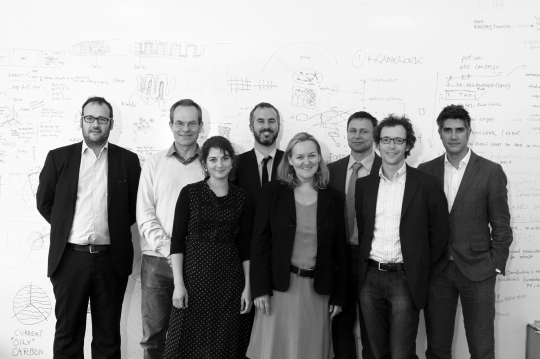
Sustainability, one of three studio teams from the summer of 2010
For instance, in the Studio on Sustainability we knew that building physics, transit, and policy would be essential areas. These are quite predictable. But we also sought some perspectives that might at first be unexpected. The thought behind this is simple: if you only include the regular suspects you will only get regular results. The notion of an "X-factor" can certainly go too far. For instance, although juggling is certainly an unexpected perspective for a conversation about sustainability, it's probably not the most relevant. The X-factor works best when it's someone who has a demonstrated commitment to the studio theme even if their everyday work does not 100% overlap with it.
We wanted the Studio to be as autonomous as possible so that their recommendations would truly be their own. For this reason we decided from the start that Sitra's role would be to support the studio rather than play an active role such as facilitating or otherwise being part of the Studio team.
Here are the basic rules of thumb that we used when thinking about the mix of the team and how to select the right individuals:
- Keep it small: With too few people there's a danger that conversation will not be robust enough, but with too many people in the room it's difficult to have a single conversation. Based on experience, and a bit of advice from Dan Goldin, a team of eight is optimal and we've now seen that it works very well. Some things work in large groups, but strategy sessions are not one of them. Eight is also small enough that you can fit into two cars. Although this seems like a small thing, the logistics required to smoothly pull off an event like HDL Studios are not to be underestimated.
- No room for duplicates: The studio team will be working quickly, which means that the collective expertise and experience in the room is the team's largest asset. Although team members may have some overlaps in their interests, it's best if each member is the master of their own domain and offers serious, focused expertise about their field. Each member becomes a 'representative' of their expertise and no one is redundant.
- Only accept the best: When it comes to selecting individuals, we've gone straight to the top. Across the board, we feel that the studio members we've attracted are either at the top of their respective fields or upcoming talents. High quality input may not quite guarantee high quality output, but it's certainly a prerequisite.
- Flexible expertise: It doesn't matter if you're the top expert on the planet in subject XYZ unless you're able to relate to others and convey your ideas in an open, productive manner. For this reason, we look for people who are at the top of their field, know their material inside and out, but are also naturally curious about the world around them and are able to sociably entertain models that conflict with—or even contradict—their own.
- Be (a bit) local: One of the great strengths of the HDL Studio format is that it offers a very fast and focused infusion of international expertise. But bringing in a wholly international group can lead to fruitless conversations when the cultural context is not understood. We set a rule of thumb for ourselves that two of the studio members would be Finns so there would always be 'cultural ambassadors' in the core team.
- Design is the glue: Each of the studios have two designers who work as facilitators amongst a group of peer-experts. It's their job to ensure that the conversation is balanced and holistic. Only a particular kind of designer will work in this context: they need to be able to apply their training to strategic issues. When recruiting the two designers for each studio we looked for one highly seasoned professional and one who was closer to the beginning of their career.
If these are the rules that guide our choices, one might ask how we first narrow the field. So far, the best indicator we have is that the kinds of people who succeed in collaborations with HDL are those who have significant experience in multiple cultures. Marco likes to use the term Third Culture Kid. This may be "culture" as it's typically defined or it may also refer to different cultures of expertise or work.
If I have the choice between an expert in astrophysics and an expert in astrophysics with a previous background in agriculture, my bet is on the latter. There's something about having lived in multiple cultures that prepares an individual for the kind of lateral thinking that is required in an HDL Studio.
Finally, the mix of the studio in terms of both expertise and personality is important. While one my be able to judge an individual's expertise by broswing a CV and reading some publications, it's very difficult to assess whether an individual will work well as part of a team unless you meet them in person. Sharing a phone call works too, but it's not as effective as having a face to face conversation with someone.
We also relied on our personal networks to recommend people who they thought would be right for this kind of experiment and followed up recommendations with phone conversations or, when possible, in-person visits.
For all of these reasons listed above, we devote a lot of time to sketching out the right mix for a team, courting a qualified pool of invitees, and working to secure their participation. As a reference, the process of defining the HDL Studio teams began eight months before the first studio, with the last three months of that period being the most intense. Without a solid team the entire Studio is moot, so it was worth it invest in taking the necessary time to ensure that the starting point would be strong.
Yesterday was a whirlwind tour of Jyväskylä, which we visited to see a cross section of how one city thinks about its elders.
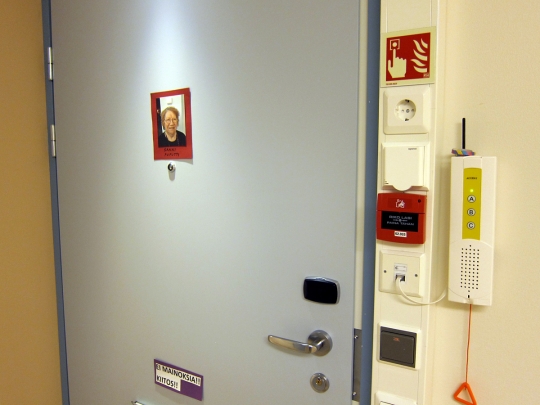
The balance between the human and infrastructural/institutional presence at an individual's front door inside an assisted living facility... interesting.
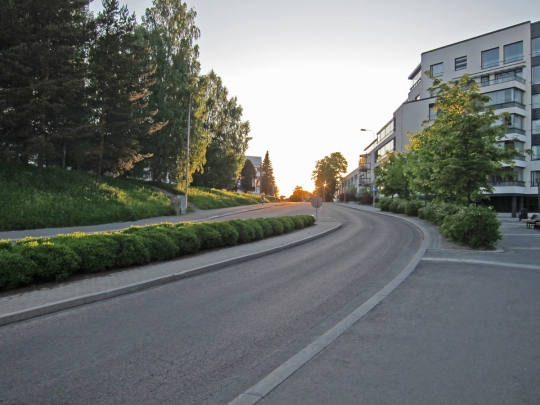
What it looks like at 11pm in the summer when you're at 62° north.
As Helsinki continues to warm up for the summer, we welcome a new group of guests who comprise our third HDL Studio, this time on ageing society. While the first two studios had relatively focused questions, this one is more open-ended. Around the world there's a lot of attention towards the coming "silver wave" of retiring Baby Boomers whose quantity, diversity of needs, and consumer orientation will put new demands on welfare systems. The challenge we face now, and the focus of this studio, is to develop an understanding of the relationships within this knotty issue—How do the pieces fit together?
Is ageing a health issue or a social issue? Is it a question of environments, isolation, mobility, independence? Is ageing just about the elderly? The nature of the challenge exists somewhere at the intersection of these many issues.
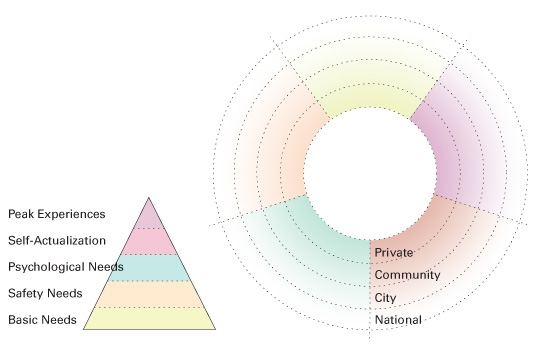
Maslow's hierarchy of needs expanded to a torus of actors.
Christina and Ankki, two Aalto University students who have been doing preparatory research in advance of the Ageing Studio's arrival, struck on an interesting way to map this web of needs and the groups responding to them. They started with Maslow's Hierarchy of needs in one dimension and the different scales of activity and support—from private, to city, to national—in another dimension. The key actors related to ageing are then slotted into this matrix. The result looks something like this draft:
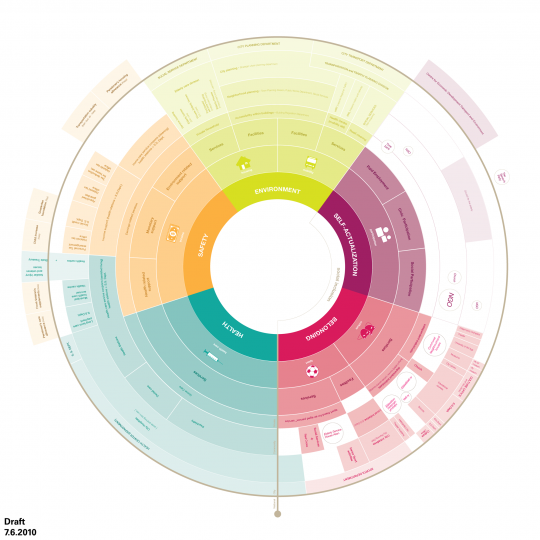
The network of actors related to ageing in the city of Helsinki. In progress.
The visualization itself makes the gaps very apparent and the act of drawing becomes a process of discovery. More as this work develops.
And now, a hearty welcome to our HDL Studio on Ageing:
- Onny Eikhaug. Programme Leader, Design for All, Norwegian Design Council
- Dr. Marianne Guldbrandsen. Chief Designer, Design Council, London
- Alberto Holly. Professor Emeritus, University of Lausanne
- Inderpaul Johar. Co-founder, Zero-Zero Architecture Research, London
- Petri Lehto. Ministry of Employment and the Economy, Helsinki
- Dr. John Ruark. Adjunct Clinical Associate Professor of Psychiatry, Stanford University
- Hannele Seeck. Adjunct Professor, University of Helsinki
- Emily Thomas. Founding Director, Aequitas Consulting
If you want a peek into the life of the studio, follow #HDL2010 on Twitter where Inderpaul Johar is actively posting. Tomorrow we're heading to Jyväskylä for a full day of site visits as the studio continues to immerse themselves in the challenge.
This summer HDL is hosting three separate studios here in Helsinki, each focusing on a topic that is critical to maintaining the wellbeing of Finland. Education, Sustainability, and Ageing are huge topics and there's no pretense that the studios will magically "solve" these issues. Rather, the goal of these studios is act as rocket fuel in the process of developing a strategic understanding of the issue. HDL Studios are part of a longer arc of work that began with the writing the Challenge Briefings last fall and will continue through this fall, if not longer.
HDL Studios are about making sure we ask the right questions. It's more about inspiration and insight than truth, as Rama Gheerawo eloquently put it.
Each studio is a group of eight people who've been assembled to represent key perspectives on the problem. For the education studio we have people with very deep experience in founding and running schools, extensive classroom teaching, as well as health, developmental psychology, learning, and media, and two designers with backgrounds in strategic work. Their task is to help the Ministry of Education think about its work in new ways, particularly with regards to Finland's dropouts.
In shaping the team HDL has been careful to look for people who have different points of view but are also able to suspend disbelief and engage other ways of thinking. It's probably also worth mentioning that for us the process of building the team was an intensely social one. Not only do the studio members have to be at the top of their field and able to collaborate well, but this specific group of people needs to gel socially. From the intensity of the work over the past couple days it seems like this is exactly what has happened.
Without further ado, the HDL Studio on Education:
- Dr. Jane Holmes Bernstein. Senior Associate in Psychology/Neuropsychology, Children's Hospital Boston
- Maja Kecman. Senior Associate, Helen Hamlyn Centre, Royal College of Art
- Lai Cheng Lim, Principal of the Raffles Institution, Singapore
- Ann McCormick. CEO, Learning Friends Inc. in California's Bay Area
- Roope Mokka. Development Director of Demos Helsinki
- Linda Nathan. Founding Headmaster of Boston Arts Academy
- Darrel Rhea. CEO of Cheskin Added Value in California's Bay Area
- Dr. Juha Teperi. Programme Director, Ministry of Social Affairs and Health
The team is here in Helsinki for just one week. In this incredibly limited window of opportunity we've pre-arranged a schedule for them that is front-loaded with opportunities to hear from local stakeholders before transitioning into synthesis mode, which is where they're at right now as Thursday winds down.
Monday was focused on macro-level issues here in Finland. From the socioeconomic development of the country to the realities of multiculturalism in schools, it was an intense and diverse brain dump of information. The next day we visited a school in Helsinki to see what education looks like on the ground. Wednesday and Thursday were intense days of discussion and now everyone is working in smaller groups to bring the salient thoughts into focus. Tomorrow afternoon the studio will share their thoughts with guests from Helsinki and Brussels and then we'll continue that discussion over dinner.
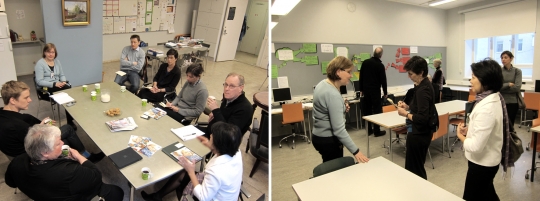
Principal Erja Hoven taking the studio on a tour of Ressu, one of Helsinki's comprehensive schools
Meals are not to be underestimated in a process like this. Since the team has precious little time together, meals are very important opportunities to change the tenor of the conversation and let ideas percolate in a different way. At one point on Tuesday I counted seventeen cups and beverage containers on the table with eight chairs around it—a messy table is a productive table.
More soon.


